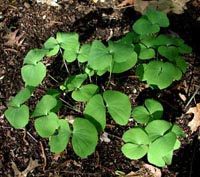Resource Library
Plant of the Week: Twinleaf
The University of Arkansas System Division of Agriculture does not promote, support or recommend plants featured in "Plant of the Week." Please consult your local Extension office for plants suitable for your region.
Plant of the Week
Twinleaf
Latin: Jeffersonia diphylla

Plants have so many stories to tell that I’m often conflicted as I pick and choose between various threads that could be followed. Many plants have associations with famous people or can be used as examples for grand scientific discoveries. Today’s plant, Jeffersonia, has both.
Twinleaf, Jeffersonia diphylla, a wildflower of our eastern woodlands is a prime example. It belongs to the barberry family, and as such, is most closely related to the mayapple. In fact, when Linnaeus named it in 1753, he lumped these two plants into the same genus.
But 40 years later, the American botanist Benjamin Barton recognized the considerable difference between the two plants and separated twinleaf into its own genus. He named it in honor of his friend Thomas Jefferson.
Twinleaf is an herbaceous perennial that forms a tight clump with 8-inch long petioles emerging directly from the crown. The leaf is about 6 inches long and 5 inches across and cleft evenly down the middle, taking on the shape of a butterfly in flight. The species epitaph translates as "two leaves," a reference to the divided nature of the leaves.
Solitary, upfacing, white flowers appear in March with the emerging leaves. The flowers are about the size a quarter with eight to a dozen petals surrounding a whorl of conspicuous stamens and what develops into a leathery seed capsule. The flowers are extremely fragile, often lasting only a couple days.
Twinleaf is found from Ontario southward down the spine of the Appalachian mountains to northern Alabama. It occurs in cool, moist, shaded sites. As it turns out, a second species of twinleaf was later discovered, but this one occurred on the other side of the world in northeastern China and Korea.
This species, J. dubia, is quite similar to our native Jeffersonia, except the Asian counterpart has lavender flowers. Since the time of Linnaeus, botanists had noticed the similarity between the flora of eastern Asia and eastern North America. But, it was not until 1859 this relationship was scientifically codified by the Harvard botanist Asa Gray (1810 – 1888).
Gray had spent his career identifying and classifying the flora of North America, and because of this lifelong work, became our nation’s most famous botanist. In 1856, Gray had enough data to publish his paper on what became known as "disjunct populations."
Disjunctions exist when two or more closely related species occur in widely separated locations. Today, 65 genera are considered as having plant populations based in Asia and eastern North America.
Gray, as it turned out, had puzzled over this question for a few years, and since 1855 had corresponded with an English naturalist about how the phenomenon might be explained.
This naturalist, Charles Darwin, used his American friend to help get an American edition of The Origin of Species published in 1859.
Today, we know that a vast, continuous temperate forest existed around the globe during the Tertiary period, the geologic time from the extinction of the dinosaurs 65 million years ago to about 30 million years ago. During more recent epochs large swaths of the forest were destroyed as climates changed, leaving behind pockets of isolated plant populations.
Plant disjunction was one of the bits of supporting evidence used by geologists to prove the theory of continental drift, which became widely accepted in the 1960s.
Jeffersonia is worthy of space in the shade garden for it has such an interesting story to tell. I have plants in a sand/peat bed that have grown with no attention for about eight years. In another location, plants are in a rich, well-drained loam soil and they too have proven easy to grow.
Some references suggest they do best in an alkaline soil, but mine are in acidic soils and seem just fine. I have seen no indication of problems, but the plants are slow growing and ephemeral, with the foliage dying down by August when it gets too hot.
By: Gerald Klingaman, retired
Extension Horticulturist - Ornamentals
Extension News - January 21, 2005
The University of Arkansas System Division of Agriculture does not maintain lists of retail outlets where these plants can be purchased. Please check your local nursery or other retail outlets to ask about the availability of these plants for your growing area.